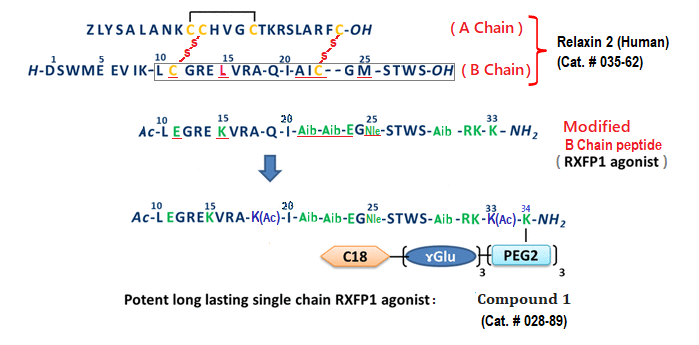
Abstract: Despite beneficial effects in acute heart failure, the full therapeutic potential of recombinant relaxin-2 has been hampered by its short half-life and the need for intravenous administration limiting its use to intensive care units. A multiparametric optimization of the relaxin B-chain led to the identification of single chain lipidated peptide agonists of RXFP1 like SA10SC-RLX with subcutaneous bioavailability and extended half-life. SA10SC-RLX has sub nanomolar activity on cells expressing human RXFP1 and molecular modeling associated with the study of different RXFP1 mutants was used to decipher the mechanism of SA10SC-RLX interaction with RXFP1. Telemetry was performed in rat where SA10SC-RLX was able to engage RXFP1 after subcutaneous administration without tachyphylaxis after repeated dosing. Renal blood flow was then used as a translational model to evaluate RXFP1 activation. SA10SC-RLX increased renal blood flow and decreased renal vascular resistance in rats as reported for relaxin in humans. In conclusion, SA10SC-RLX mimics relaxin activity in in vitro and in vivo models of acute RXFP1 engagement. SA10SC-RLX represents a new class of long-lasting RXFP1 agonist, suitable for once daily subcutaneous administration in patients and potentially paving the way to new treatments for chronic fibrotic and cardiovascular diseases.
Illiano S, Poirier B, Minoletti C, et al. Characterization of a new potent and long-lasting single chain peptide agonist of RXFP1 in cells and in vivo translational models. Sci Rep. 2022;12(1):20435.
Abstract: We recently described C18 fatty acid acylated peptides as a new class of potent long-lasting single-chain RXFP1 agonists that displayed relaxin-like activities in vivo. Early pharmacokinetics and toxicological studies of these stearic acid acylated peptides revealed a relevant oxidative metabolism occurring in dog and minipig, and also seen at a lower extent in monkey and rat. Mass spectrometry combined to NMR spectroscopy studies revealed that the oxidation occurred, unexpectedly, on the stearic acid chain at w-1, w-2 and w-3 positions. Structure-metabolism relationship studies on acylated analogues with different fatty acids lengths (C15-C20) showed that the extent of oxidation was higher with longer chains. The oxidized metabolites could be generated in vitro using liver microsomes and engineered bacterial CYPs. These systems were correlating poorly with in vivo metabolism observed across species; however, the results suggest that this biotransformation pathway might be catalyzed by some unknown CYP enzymes.
Esposito S, Krick A, Pasquier O, et al. Fatty acid acylated peptide therapeutics: discovery of omega-n oxidation of the lipid chain as a novel metabolic pathway in preclinical species. Journal of Pharmaceutical and Biomedical Analysis. 2023;227:115256.
| Catalog# | Product | Standard Size | Price |
|---|---|---|---|
| 028-89 | SA10SC-RLX / Compound 1 | 100 μg | $368 |
Social Network Confirmation